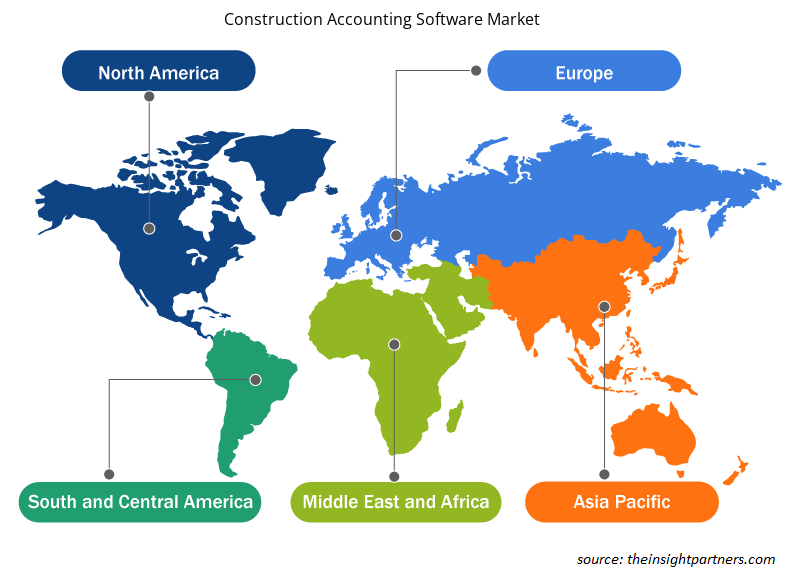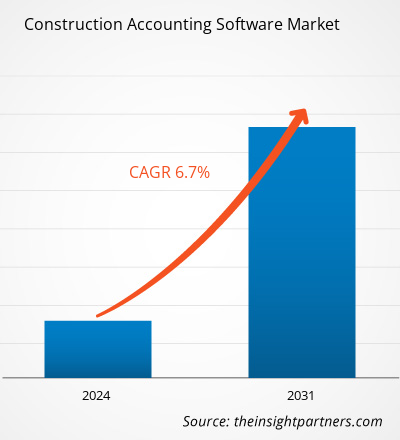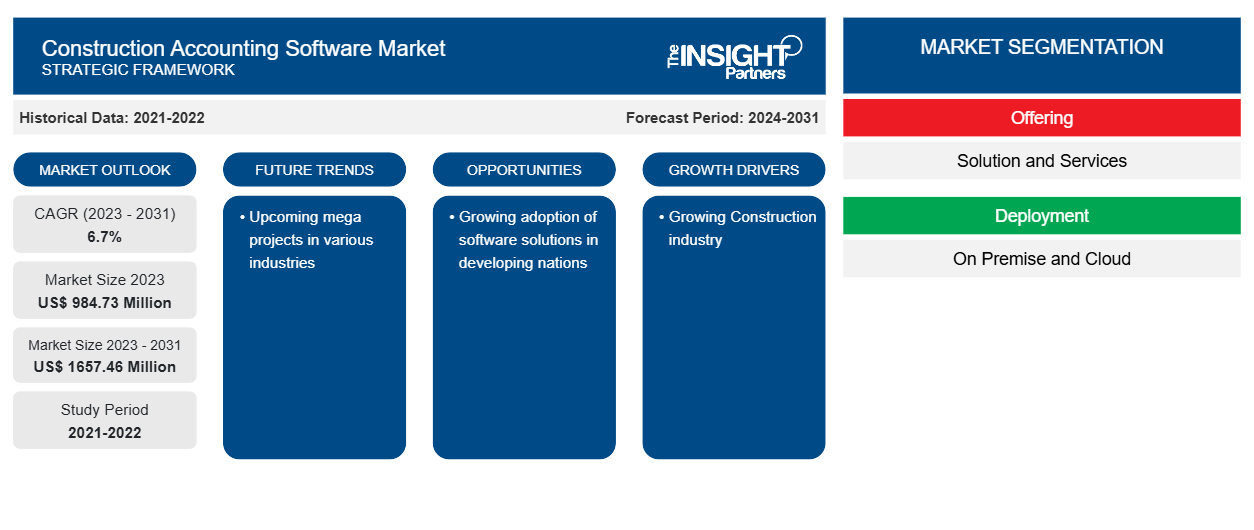Der Markt für Baubuchhaltungssoftware soll von 984,73 Millionen US-Dollar im Jahr 2023 auf 1.657,46 Millionen US-Dollar im Jahr 2031 anwachsen. Der Markt wird zwischen 2023 und 2031 voraussichtlich eine durchschnittliche jährliche Wachstumsrate von 6,7 % verzeichnen. Die zunehmende Digitalisierung in der Baubranche und die wachsende Bauindustrie werden voraussichtlich weiterhin wichtige Trends auf dem Markt bleiben.
Marktanalyse für Buchhaltungssoftware im Baugewerbe
Die steigende Nachfrage aus dem Wohn- und Gewerbesektor treibt die wachsende Baubranche an. Dieser Faktor führt dazu, dass die Finanzverwaltung der Bauunternehmen Baubuchhaltungssoftware einführt. Die Software hilft Bauunternehmen dabei, Geldein- und -ausgänge genau zu verfolgen. Die Software behandelt Aspekte der Baubranche, wie z. B. Auftragskosten und Einbehalte. Solche Funktionen von Baubuchhaltungssoftware führen zu ihrer Einführung.
Marktübersicht für Buchhaltungssoftware im Baugewerbe
Baubuchhaltungssoftware bietet kleinen und mittleren Bauunternehmen sowie großen Bauunternehmen Finanzmanagementtools für Bauprojekte und -aktivitäten. Diese Softwarelösung bietet Funktionen wie Lohn- und Gehaltsabrechnung, Auftragskostenrechnung, Hauptbuchhaltung, Kreditoren- und Debitorenbuchhaltung (AP/AR), Prüfberichte und mehr. Einige Baubuchhaltungslösungen konzentrieren sich auf bestimmte Finanzinformationen für Projekte, während andere Buchhaltungseinblicke für das gesamte Unternehmen bieten.
Passen Sie diesen Bericht Ihren Anforderungen an
Sie erhalten kostenlos individuelle Anpassungen an jedem Bericht, einschließlich Teilen dieses Berichts oder einer Analyse auf Länderebene, eines Excel-Datenpakets sowie tolle Angebote und Rabatte für Start-ups und Universitäten.
-
Holen Sie sich die wichtigsten Markttrends aus diesem Bericht.Dieses KOSTENLOSE Beispiel umfasst eine Datenanalyse von Markttrends bis hin zu Schätzungen und Prognosen.
Treiber und Chancen auf dem Markt für Buchhaltungssoftware für das Baugewerbe
Wachsende Bauindustrie
Die Baubranche ist führend bei der Entwicklung und Verbesserung von Infrastrukturen wie Straßen, Eisenbahnen, Flughäfen und Häfen. Diese Infrastrukturinvestitionen verbessern die Konnektivität, den Handel und die wirtschaftliche Entwicklung eines jeden Landes. Daher fördert die wachsende Baubranche die Einführung von Baubuchhaltungssoftware, die für Buchhaltungsanwendungen verwendet wird, darunter Kreditorenbuchhaltung, Debitorenbuchhaltung, Lohnbuchhaltung und Hauptbuchhaltung sowie Module für Auftragskosten, Kostenvoranschläge, Gerätekontrolle, Bestandskontrolle, Einkaufsbestellungen, Arbeitsaufträge und AIA-Abrechnungen.
Zunehmende Nutzung von Softwarelösungen in Entwicklungsländern
Entwicklungsländer wie Indien und China greifen schnell auf die Digitalisierung zurück, was zur Einführung von Softwarelösungen in verschiedenen Branchen, darunter auch der Baubranche, führt. Diese Länder setzen in großem Umfang Baubuchhaltungssoftware ein, um Herausforderungen wie komplexe Tabellenkalkulationen, verlorene Quittungen und endlosen Papierkram zu bewältigen. Die Einführung der Software bietet Bauunternehmen Funktionen für das Finanzmanagement.digitalization, which is leading to the adoption of software solutions in various industries, including the construction industry. These countries are widely adopting construction accounting software to tackle challenges such as complex spreadsheets, lost receipts, and never-ending paperwork. The software adoption provides financial management functionality for construction firms.
Segmentierungsanalyse des Marktberichts zur Baubuchhaltungssoftware
Wichtige Segmente, die zur Ableitung der Marktanalyse für Baubuchhaltungssoftware beigetragen haben, sind Angebot, Bereitstellung und Anwendung.
- Basierend auf dem Angebot ist der Markt für Baubuchhaltungssoftware in Lösungen und Dienstleistungen unterteilt. Das Lösungssegment hat im Jahr 2023 den größten Marktanteil.
- Der Markt ist nach Bereitstellung segmentiert in On-Premise und Cloud . Das Cloud-Segment wird voraussichtlich mit der höchsten durchschnittlichen jährlichen Wachstumsrate wachsen.CAGR.
- Nach Anwendung ist der Markt in kleine und mittlere Bauunternehmen und große Bauunternehmen segmentiert. Das Segment der kleinen und mittleren Bauunternehmen wird voraussichtlich mit der höchsten durchschnittlichen jährlichen Wachstumsrate wachsen.CAGR.
Marktanteilsanalyse für Buchhaltungssoftware im Baugewerbe nach geografischen Gesichtspunkten
Der geografische Umfang des Marktberichts für Baubuchhaltungssoftware ist hauptsächlich in fünf Regionen unterteilt: Nordamerika, Asien-Pazifik, Europa, Naher Osten und Afrika sowie Süd- und Mittelamerika.
Die Region Nordamerika hielt einen bedeutenden Marktanteil. Die wachsende Bauindustrie ist der Hauptfaktor, der den Markt in der Region antreibt. Die Bauindustrie ist einer der Hauptfaktoren für die Wirtschaft der Länder der Region, was zur Einführung von Softwarelösungen zur Vereinfachung der Aufgaben in der Baubuchhaltung geführt hat. Die steigende Zahl an Bauprojekten und der wachsende Wohnsektor treiben das Marktwachstum an.
Regionale Einblicke in den Markt für Buchhaltungssoftware für das Baugewerbe
Die regionalen Trends und Faktoren, die den Markt für Buchhaltungssoftware für das Baugewerbe im Prognosezeitraum beeinflussen, wurden von den Analysten von Insight Partners ausführlich erläutert. In diesem Abschnitt werden auch die Marktsegmente und die Geografie von Buchhaltungssoftware für das Baugewerbe in Nordamerika, Europa, im asiatisch-pazifischen Raum, im Nahen Osten und Afrika sowie in Süd- und Mittelamerika erörtert.

- Erhalten Sie regionale Daten zum Markt für Buchhaltungssoftware für das Baugewerbe
Umfang des Marktberichts für Buchhaltungssoftware im Baugewerbe
| Berichtsattribut | Details |
|---|---|
| Marktgröße im Jahr 2023 | 984,73 Millionen US-Dollar |
| Marktgröße bis 2031 | 1657,46 Millionen US-Dollar |
| Globale CAGR (2023 - 2031) | 6,7 % |
| Historische Daten | 2021-2022 |
| Prognosezeitraum | 2024–2031 |
| Abgedeckte Segmente |
Durch das Angebot
|
| Abgedeckte Regionen und Länder |
Nordamerika
|
| Marktführer und wichtige Unternehmensprofile |
|
Dichte der Marktteilnehmer für Buchhaltungssoftware für das Baugewerbe: Die Auswirkungen auf die Geschäftsdynamik verstehen
Der Markt für Buchhaltungssoftware für das Baugewerbe wächst rasant. Dies wird durch die steigende Nachfrage der Endnutzer aufgrund von Faktoren wie sich entwickelnden Verbraucherpräferenzen, technologischen Fortschritten und einem größeren Bewusstsein für die Vorteile des Produkts vorangetrieben. Mit der steigenden Nachfrage erweitern Unternehmen ihr Angebot, entwickeln Innovationen, um die Bedürfnisse der Verbraucher zu erfüllen, und nutzen neue Trends, was das Marktwachstum weiter ankurbelt.
Die Marktteilnehmerdichte bezieht sich auf die Verteilung der Firmen oder Unternehmen, die in einem bestimmten Markt oder einer bestimmten Branche tätig sind. Sie gibt an, wie viele Wettbewerber (Marktteilnehmer) in einem bestimmten Marktraum im Verhältnis zu seiner Größe oder seinem gesamten Marktwert präsent sind.
Die wichtigsten Unternehmen auf dem Markt für Buchhaltungssoftware für das Baugewerbe sind:
- Sage Group plc
- Chetu Inc
- Procore Technologies
- Deltek Inc
- Foundation Software, LLC
- Frisches Buch
Haftungsausschluss : Die oben aufgeführten Unternehmen sind nicht in einer bestimmten Reihenfolge aufgeführt.

- Überblick über die wichtigsten Akteure auf dem Markt für Buchhaltungssoftware für das Baugewerbe
Neuigkeiten und aktuelle Entwicklungen zum Markt für Buchhaltungssoftware für das Baugewerbe
Der Markt für Buchhaltungssoftware für das Baugewerbe wird durch die Erhebung qualitativer und quantitativer Daten nach Primär- und Sekundärforschung bewertet, die wichtige Unternehmenspublikationen, Verbandsdaten und Datenbanken umfasst. Nachfolgend sind einige der Entwicklungen auf dem Markt für Buchhaltungssoftware für das Baugewerbe aufgeführt:
- Kojo, die führende Plattform für Material- und Bestandsmanagement in der Baubranche, hat die Einführung von Kojo AP (Kreditorenbuchhaltung) angekündigt. Kojo AP ist eine Reihe von Funktionen, die speziell für Buchhaltungsteams im gewerblichen Bauwesen entwickelt wurden, um den letzten Schritt im Materialmanagement-Workflow abzudecken: Zahlungen. Kojo AP eliminiert viele der manuellen Dateneingabeprozesse für Buchhaltungsteams von Bauunternehmern, erkennt automatisch Fehler auf Rechnungen und ermöglicht es Lieferanten, direkt in einem System bezahlt zu werden. (Quelle: Kojo, Pressemitteilung, Mai 2024)
Marktbericht zu Buchhaltungssoftware für das Baugewerbe – Umfang und Ergebnisse
Der Bericht „Marktgröße und Prognose für Buchhaltungssoftware im Baugewerbe (2021–2031)“ bietet eine detaillierte Analyse des Marktes, die die folgenden Bereiche abdeckt:
- Marktgröße und Prognose für Baubuchhaltungssoftware auf globaler, regionaler und Länderebene für alle wichtigen Marktsegmente, die im Rahmen des Berichts abgedeckt sind
- Markttrends für Baubuchhaltungssoftware sowie Marktdynamik wie Treiber, Einschränkungen und wichtige Chancen
- Detaillierte PEST/Porters Five Forces- und SWOT-Analyse
- Marktanalyse für Baubuchhaltungssoftware mit Blick auf wichtige Markttrends, globale und regionale Rahmenbedingungen, wichtige Akteure, Vorschriften und aktuelle Marktentwicklungen
- Branchenlandschaft und Wettbewerbsanalyse, die die Marktkonzentration, Heatmap-Analyse, prominente Akteure und aktuelle Entwicklungen auf dem Markt für Baubuchhaltungssoftware umfasst
- Detaillierte Firmenprofile
- Historische Analyse (2 Jahre), Basisjahr, Prognose (7 Jahre) mit CAGR
- PEST- und SWOT-Analyse
- Marktgröße Wert/Volumen – Global, Regional, Land
- Branchen- und Wettbewerbslandschaft
- Excel-Datensatz
Aktuelle Berichte
Verwandte Berichte
Erfahrungsberichte
Grund zum Kauf
- Fundierte Entscheidungsfindung
- Marktdynamik verstehen
- Wettbewerbsanalyse
- Kundeneinblicke
- Marktprognosen
- Risikominimierung
- Strategische Planung
- Investitionsbegründung
- Identifizierung neuer Märkte
- Verbesserung von Marketingstrategien
- Steigerung der Betriebseffizienz
- Anpassung an regulatorische Trends























 Kostenlose Probe anfordern für - Markt für Buchhaltungssoftware für das Baugewerbe
Kostenlose Probe anfordern für - Markt für Buchhaltungssoftware für das Baugewerbe